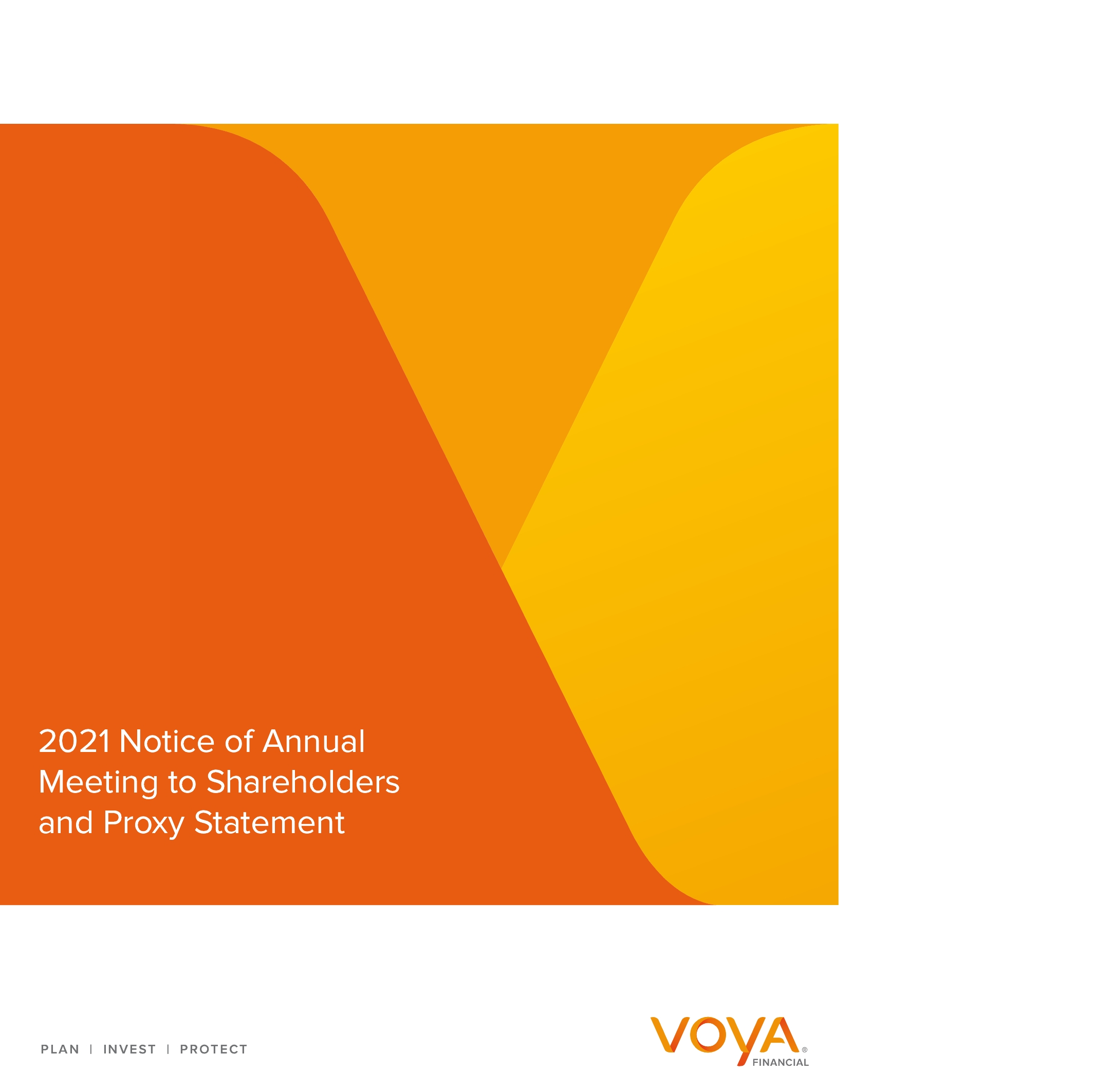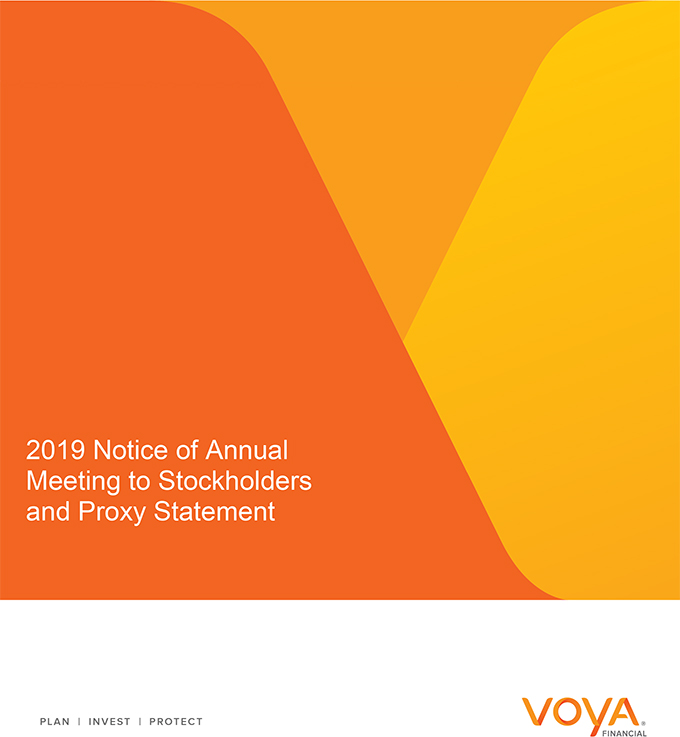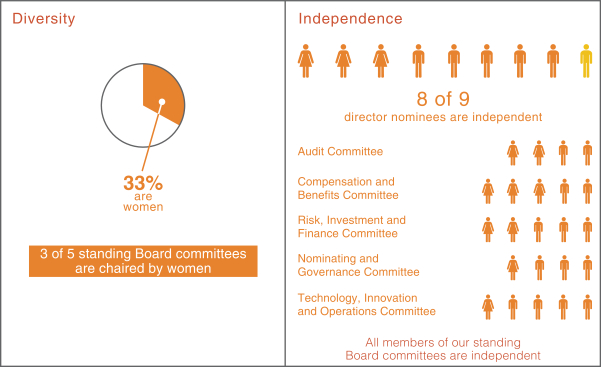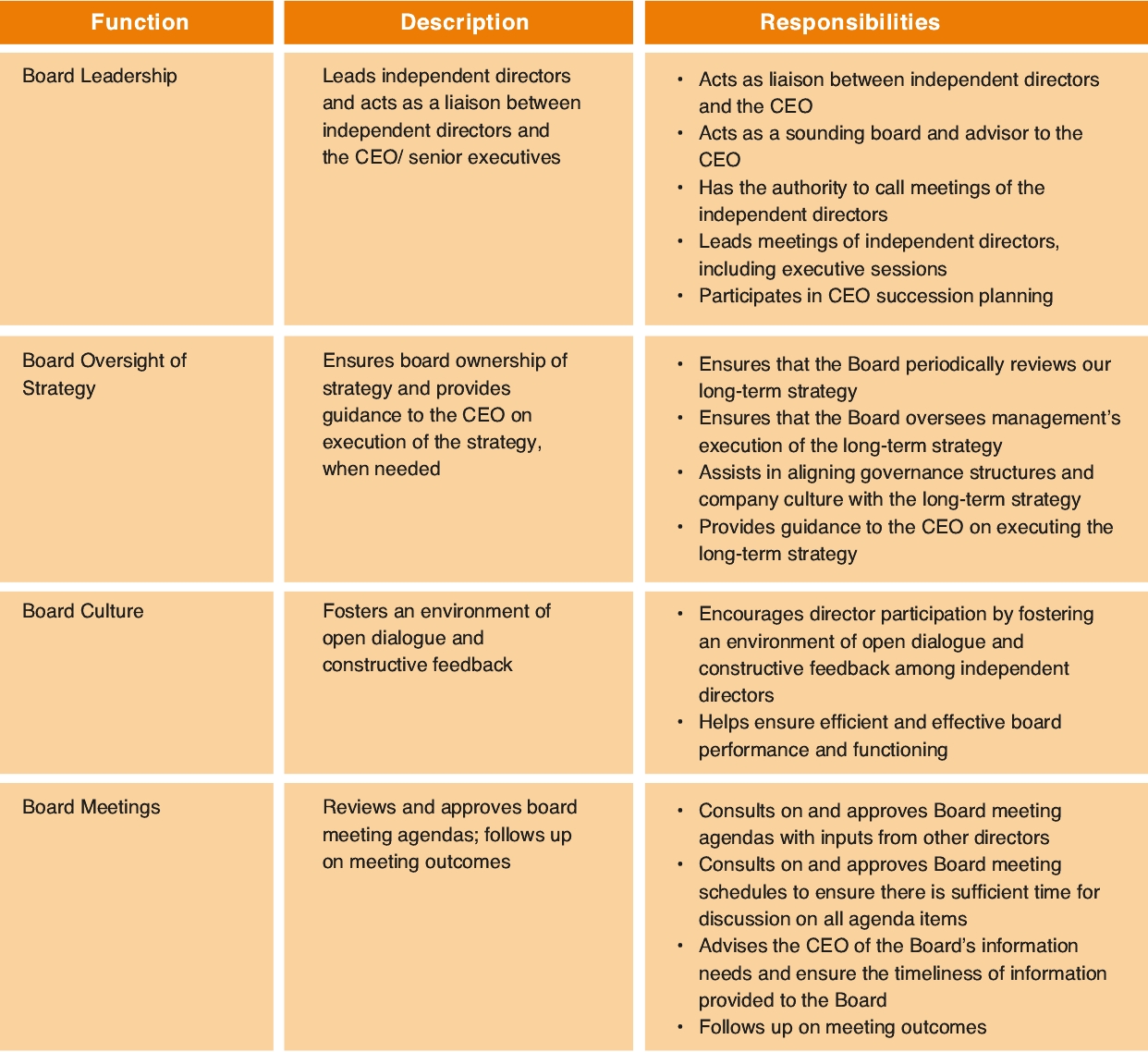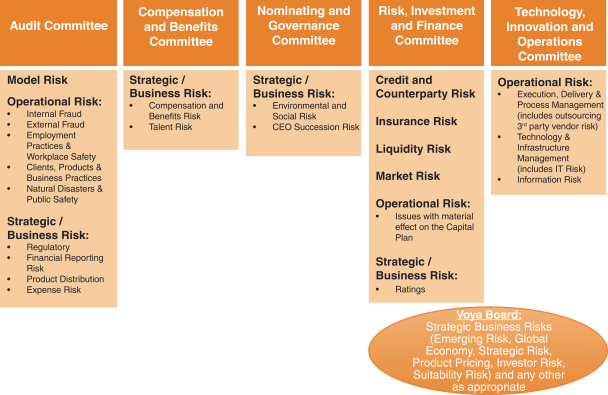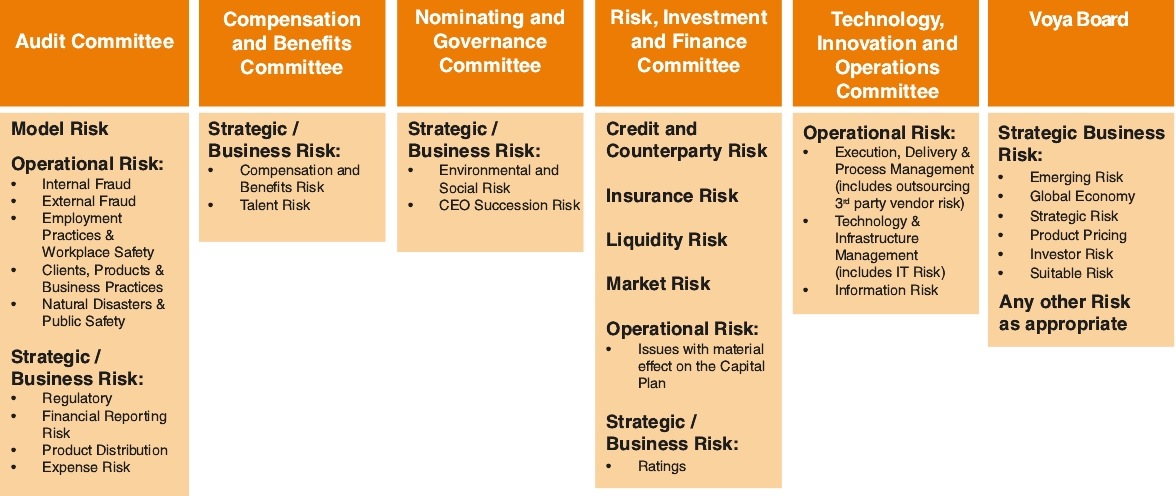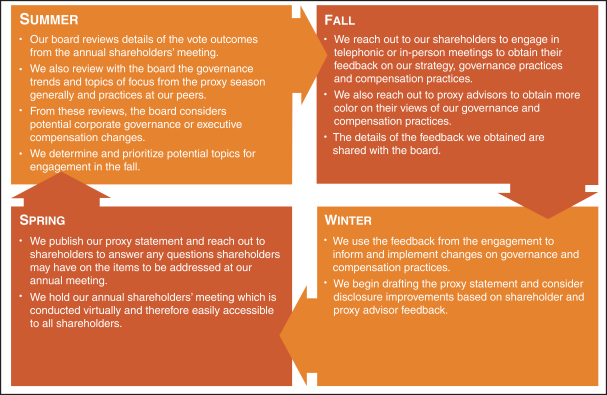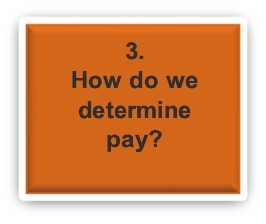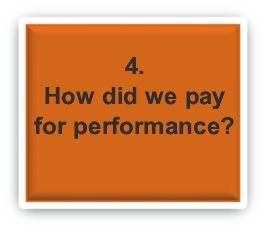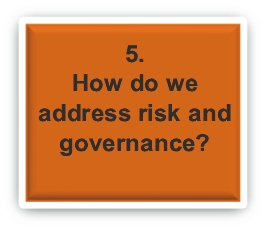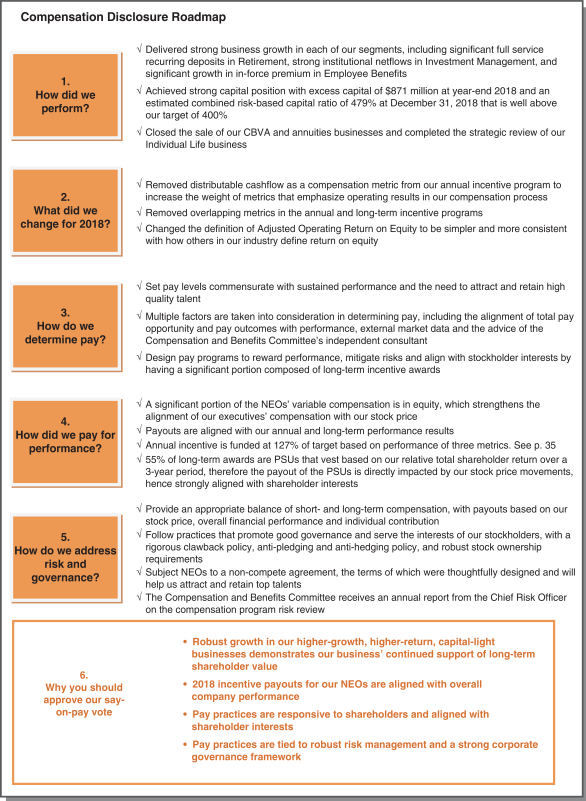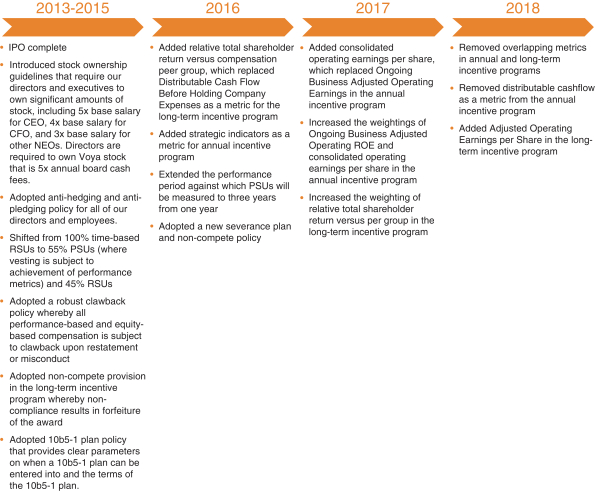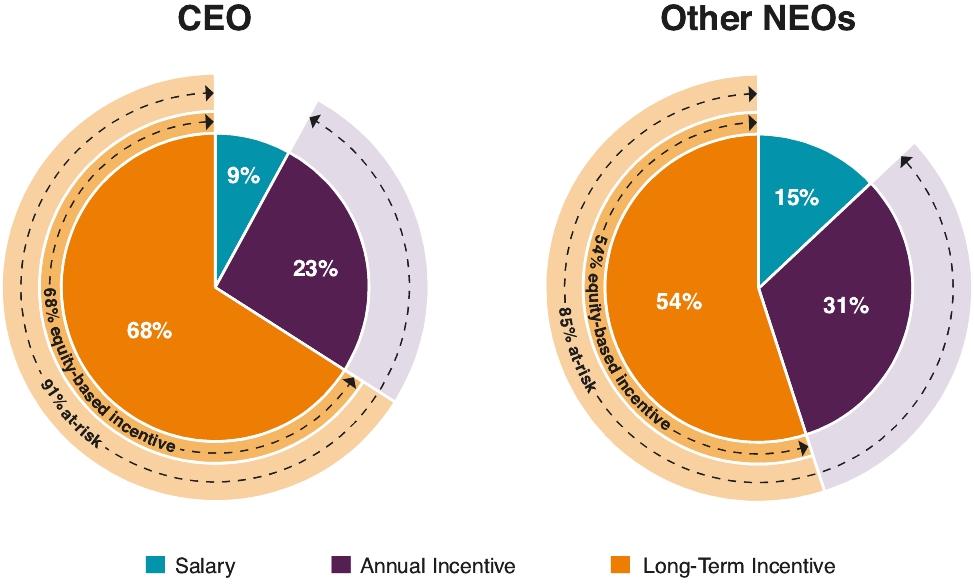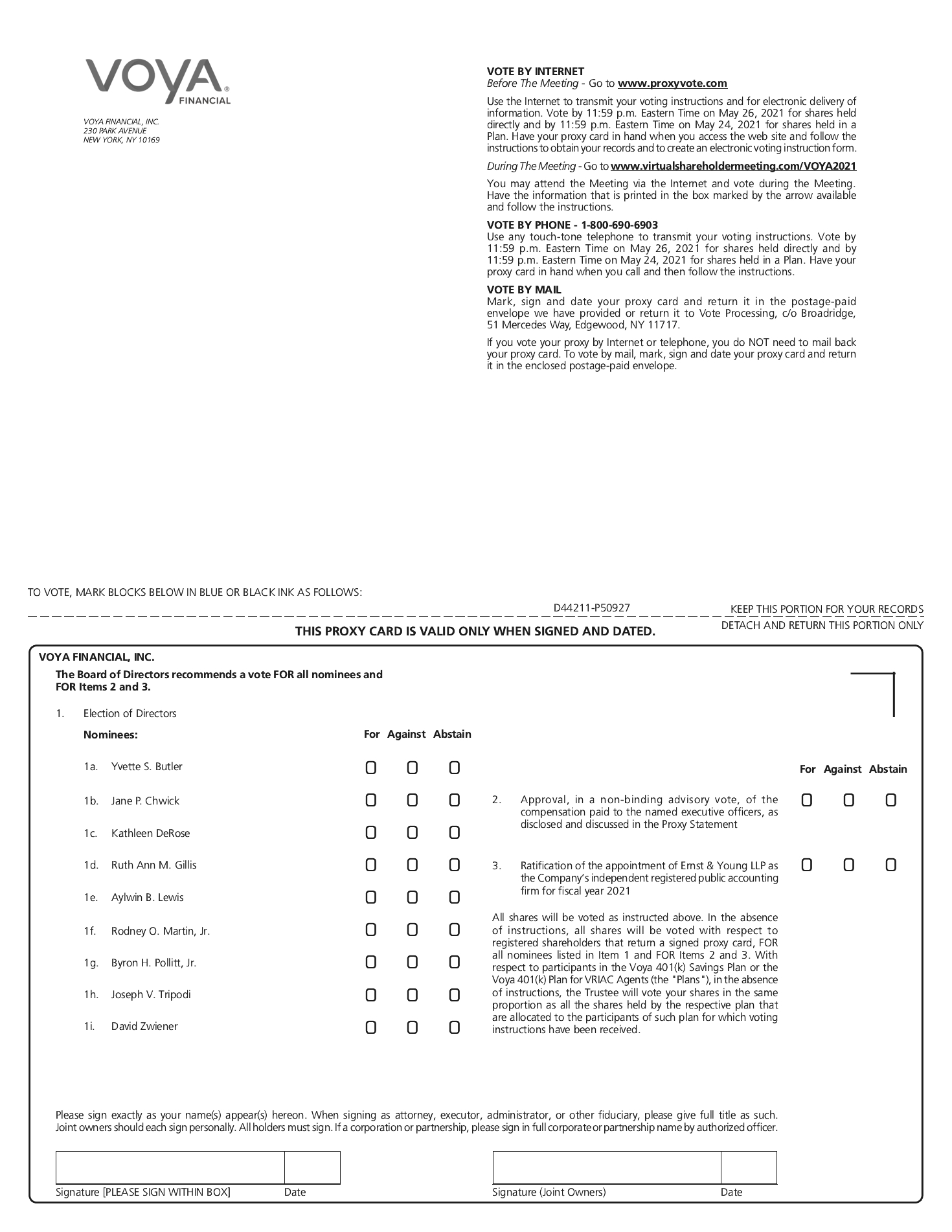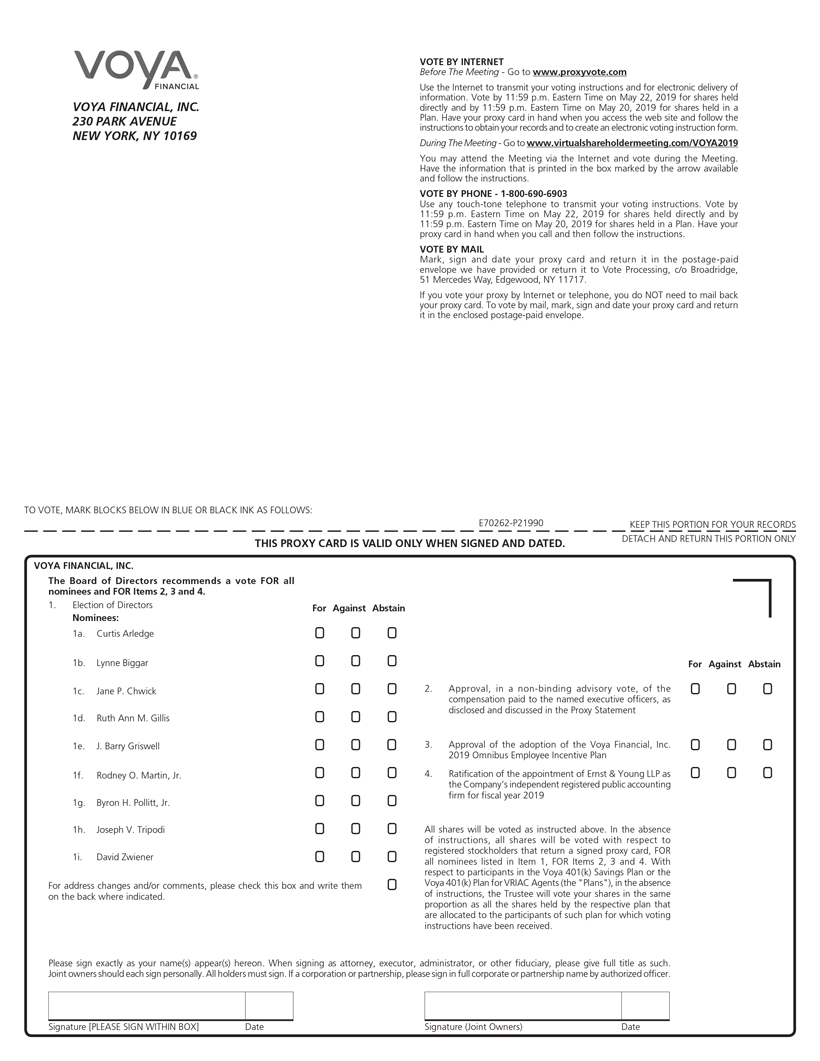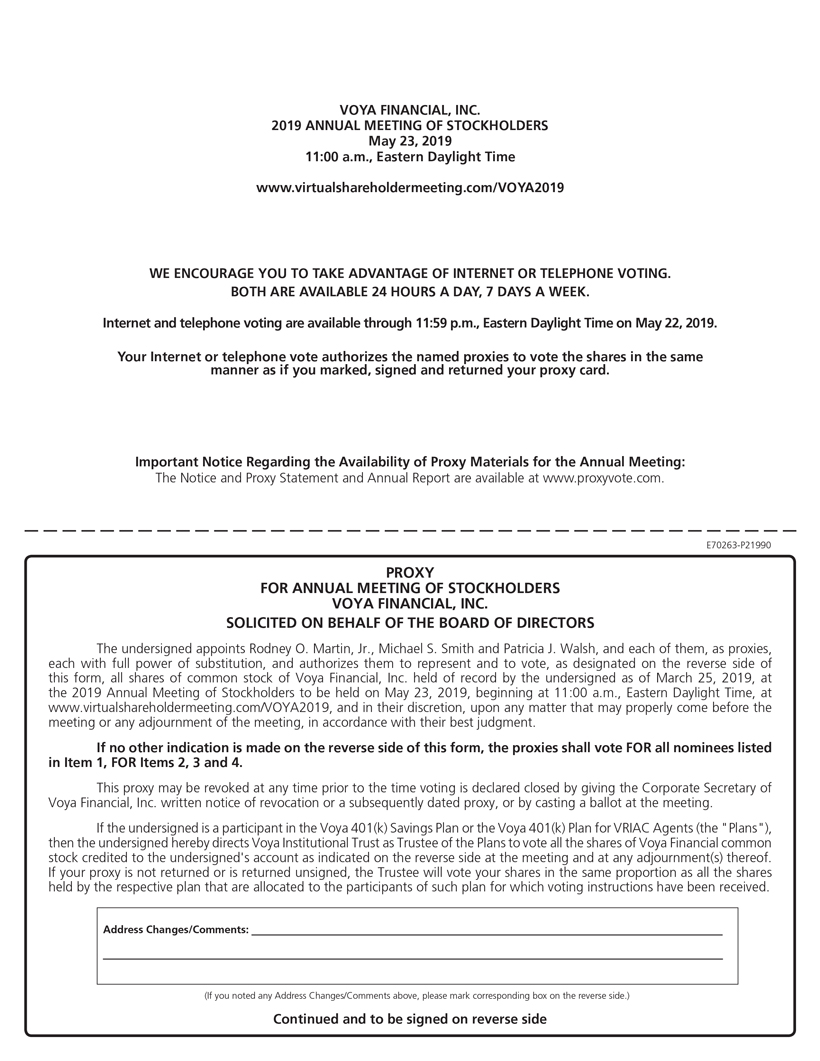TABLE OF CONTENTS
| | | | | | | | | | | | | | | | |
Name | | 2018
Target
Annual
Incentive | | | 2018 Target Annual
Incentive after
Applying 127%
Company Funding | | | 2018 Actual
Annual
Incentive
Payment | | | % of
Actual
Payment
to
Target | |
Mr. Martin. | | $ | 2,250,000 | | | $ | 2,857,500 | | | $ | 3,140,000 | | | | 140 | % |
Mr. Smith | | $ | 937,500 | | | $ | 1,190,625 | | | $ | 1,375,000 | | | | 147 | % |
Ms. Hurtsellers | | $ | 1,800,000 | | | $ | 2,286,000 | | | $ | 2,625,000 | | | | 146 | % |
Mr. Nelson | | $ | 875,000 | | | $ | 1,111,250 | | | $ | 1,375,000 | | | | 157 | % |
Ms. Walsh | | $ | 660,000 | | | $ | 838,200 | | | $ | 1,050,000 | | | | 159 | % |
Long-Term Equity-Based Incentive Compensation
Equity compensation is an important element of executive compensation, because it aligns executive pay with the performance of our stock, and in turn the interests of our
stockholders.shareholders. The size of each award is generally based on each NEO’s individual performance during the year preceding the grant date. We have historically made grants of equity-based awards in February, in respect of prior-year
individual performance.
-37-
Grants made in 20182020 for 20172019 performance
The NEOs’ long-term equity awards granted in
20182020 were considered for adjustment, either upwards or downwards, from
2017 levels,targets, based on an assessment of individual performance during
20172019 plus other factors such as executive potential and expertise.
The following table shows our NEO target long-term equity incentive amounts for 2017, expressedwere considered as a percentageone element of base salary,our NEOs’ overall total direct compensation opportunity, and, based in part on this review, total direct compensation opportunities were set with reference to median total target compensation as reflected in the comparative data. For equity awards granted in respect of 2019 performance, we made grants on February 20, 2020. Based on the evaluations set forth above, theMr. Martin received $8.86 million, Mr. Smith received $2.8 million, Ms. Hurtsellers received $2.52 million, Mr. Nelson received $2.628 million and Ms. Parent received $1.376 million in long-term incentiveequity awards that our NEOs received in 2018:
| | | | | | | | | | | | |
| | | Target Long-Term
Equity Incentive | | | Long-Term
Incentive Awards | |
| | % of base
salary | | | $ amount | |
Mr. Martin | | | 675 | % | | $ | 6,750,000 | | | $ | 6,750,000 | |
Mr. Smith | | | 285 | % | | $ | 1,781,250 | | | $ | 2,137,500 | |
Ms. Hurtsellers | | | 300 | % | | $ | 1,800,000 | | | $ | 2,250,000 | |
Mr. Nelson | | | 250 | % | | $ | 1,750,000 | | | $ | 2,187,500 | |
Ms. Walsh | | | 200 | % | | $ | 1,070,000 | | | $ | 1,391,000 | |
2020.
Although these amounts were granted in respect of
20172019 performance, because of the rules of the Securities and Exchange Commission (the “SEC”) governing the presentation of executive compensation in proxy statements, such amounts appear in the “—Summary Compensation Table” and other tables below under “—Compensation of Named Executive Officers” as compensation for
2018,2020, because such awards were granted during
2018.2020. Our equity-based awards granted under the Omnibus Plan are calculated and communicated to our NEOs based on various internal factors and qualifications, and are similar to award measurements used by companies that compete with us for executive talent. These internally communicated amounts do not necessarily reflect the “grant date fair value” of these awards (computed in accordance with FASB ASC Topic 718) which are required to be included in the “—Summary Compensation Table” below.
Grants made in
20192021 for
20182020 performance
For each of our NEOs
other(other than
Mr. Martin,the CEO), target long-term equity awards with respect to
20182020 performance were set or reviewed by the Compensation and Benefits Committee during
2018,2020, with reference to the survey and competitive data described above. The target long-term equity incentive amounts were considered as one element of our NEOs’ overall total direct compensation opportunity, and, based in part on this review, total direct compensation opportunities were set with reference to median total target compensation as reflected in the comparative data.
For equity awards granted in respect of 20182020 performance, we made grants on February 21, 2019.20, 2021. Long-term incentive awards to our NEOs were made on the basis of an evaluation of individual performance and other qualifications during 2018,2020, which evaluations are described above under “Step 3” of the Annual Incentive Compensation determination process. In 2019, in addition to RSUs and PSUs, we granted performance-based stock options to our NEOs (other than the CEO) that are subject to vesting conditions based on the achievement of certain cost savings targets on or before December 31, 2020. The options generally become exercisable one year following achievement of the relevant vesting condition. The options have a term of ten years from the grant date, but to the extent that the relevant vesting condition has not been met by December 31, 2020, any unvested options will expire without value. In the event of a change in control of the Company, the performance conditions on vesting will be waived and the options will become vested and exercisable on the first anniversary of the change in control (with exceptions for certain terminations of employment).
-38-
Based on the evaluations set forth above, Mr. Martin received $7.86$10.3 million, Mr. Smith received $2.84$3.438 million, Ms. Hurtsellers received $3.22$2.52 million and Mr. Nelson received $2.8 million and Ms. Walsh received $2.21$3.128 million in long-term equity awards. awards in 2021.
Although these amounts were granted in respect of 20182020 performance, because of the SEC rules governing the presentation of executive compensation in proxy statements, such amounts do not appear in the “—Summary Compensation Table” and other tables below under “—Executive Compensation Tables and Narratives” as compensation for 2018,2020, because such awards were granted during 2019.2021.
TABLE OF CONTENTS
EXECUTIVE COMPENSATION TABLES AND NARRATIVES
Summary Compensation Table
The following table presents the cash and other compensation for our NEOs for
2018, 20172020, 2019 and
2016.2018.
Summary Compensation Table
| | | | | | | | | | | | | | | | | | | | | | | | | | | | | | | | | | | | |
Name and Principal Position | | Year | | | Salary(1) | | | Bonus(2) | | | Stock
Awards(3) | | | Option
Awards | | | Non-Equity
Incentive Plan
Compensation(4) | | | Change in
Pension
Value(5) | | | All Other
Compensation(6) | | | Total | |
Rodney O. Martin, Jr.,
Chairman and CEO | | | 2018 | | | $ | 1,000,000 | | | $ | — | | | $ | 7,072,591 | | | $ | — | | | $ | 3,140,000 | | | $ | 39,581 | | | $ | 85,739 | | | $ | 11,337,911 | |
| | | 2017 | | | $ | 1,000,000 | | | $ | — | | | $ | 6,614,961 | | | $ | — | | | $ | 3,250,000 | | | $ | 37,906 | | | $ | 86,205 | | | $ | 10,989,072 | |
| | | 2016 | | | $ | 1,000,000 | | | $ | — | | | $ | 6,399,977 | | | $ | — | | | $ | 2,069,000 | | | $ | 37,701 | | | $ | 84,852 | | | $ | 9,591,531 | |
Michael S. Smith, EVP &CFO | | | 2018 | | | $ | 625,000 | | | $ | — | | | $ | 2,239,635 | | | $ | — | | | $ | 1,375,000 | | | $ | 25,523 | | | $ | 67,360 | | | $ | 4,332,518 | |
| | | 2017 | | | $ | 625,000 | | | $ | — | | | $ | 1,870,282 | | | $ | — | | | $ | 1,575,000 | | | $ | 47,517 | | | $ | 66,025 | | | $ | 4,183,824 | |
| | | 2016 | | | $ | 582,576 | | | $ | 350,000 | | | $ | 2,111,159 | | | $ | — | | | $ | 881,719 | | | $ | 32,053 | | | $ | 69,717 | | | $ | 4,027,224 | |
Christine Hurtsellers,
CEO Investment
Management | | | 2018 | | | $ | 600,000 | | | $ | — | | | $ | 2,357,513 | | | $ | — | | | $ | 2,625,000 | | | $ | — | | | $ | 67,360 | | | $ | 5,649,873 | |
| | | 2017 | | | $ | 600,000 | | | $ | — | | | $ | 1,574,978 | | | $ | — | | | $ | 2,898,000 | | | $ | 225,956 | | | $ | 66,334 | | | $ | 5,365,268 | |
| | | 2016 | | | $ | 466,667 | | | $ | — | | | $ | 2,286,207 | | | $ | — | | | $ | 2,178,000 | | | $ | 110,603 | | | $ | 61,700 | | | $ | 5,103,177 | |
Charles P. Nelson,
CEO Retirement and Employee Benefits | | | 2018 | | | $ | 700,000 | | | $ | 233,334 | | | $ | 2,292,021 | | | $ | — | | | $ | 1,375,000 | | | $ | 30,413 | | | $ | 73,591 | | | $ | 4,704,359 | |
| | | 2017 | | | $ | 700,000 | | | $ | 233,333 | | | $ | 2,150,422 | | | $ | — | | | $ | 1,470,000 | | | $ | 35,790 | | | $ | 105,641 | | | $ | 4,695,186 | |
| | | 2016 | | | $ | 700,000 | | | $ | 233,333 | | | $ | 1,917,463 | | | $ | — | | | $ | 866,250 | | | $ | 29,630 | | | $ | 88,154 | | | $ | 3,834,830 | |
Patricia J. Walsh,
EVP & CLO | | | 2018 | | | $ | 547,500 | | | $ | 333,333 | | | $ | 1,457,455 | | | $ | — | | | $ | 1,050,000 | | | $ | 27,308 | | | $ | 67,360 | | | $ | 3,482,956 | |
| | | | | | | | | |
Former Executive Alain M. Karaoglan, EVP &COO | | | 2018 | | | $ | 187,500 | | | $ | — | | | $ | — | | | $ | — | | | $ | 371,551 | | | $ | 41,915 | | | $ | 3,755,591 | | | $ | 4,356,558 | |
| | | 2017 | | | $ | 748,333 | | | $ | — | | | $ | 2,494,727 | | | $ | — | | | $ | 2,266,000 | | | $ | 46,605 | | | $ | 66,282 | | | $ | 5,621,948 | |
| | | 2016 | | | $ | 733,333 | | | $ | — | | | $ | 2,463,985 | | | $ | — | | | $ | 1,113,552 | | | $ | 32,740 | | | $ | 68,025 | | | $ | 4,411,635 | |
Rodney O. Martin, Jr.,
Chairman and CEO | | | 2020 | | | $1,200,000 | | | $— | | | $9,106,533 | | | $— | | | $3,000,000 | | | $40,936 | | | $249,539 | | | $13,597,008 |
| | | 2019 | | | $1,000,000 | | | $— | | | $8,141,671 | | | $— | �� | | $3,140,000 | | | $41,986 | | | $230,634 | | | $12,554,291 |
| | | 2018 | | | $1,000,000 | | | $— | | | $7,072,591 | | | $— | | | $3,140,000 | | | $39,581 | | | $85,739 | | | $11,337,911 |
Michael S. Smith,
Vice Chairman and Chief Financial Officer | | | 2020 | | | $640,000 | | | $— | | | $2,877,880 | | | $— | | | $1,290,240 | | | $57,605 | | | $69,692 | | | $4,935,417 |
| | | 2019 | | | $637,500 | | | $— | | | $1,905,932 | | | $980,778 | | | $1,512,000 | | | $55,012 | | | $68,770 | | | $5,159,992 |
| | | 2018 | | | $625,000 | | | $— | | | $2,239,635 | | | $— | | | $1,375,000 | | | $25,523 | | | $67,360 | | | $4,332,518 |
Christine Hurtsellers, CEO Investment Management | | | 2020 | | | $600,000 | | | $— | | | $2,590,085 | | | $— | | | $1,900,800 | | | $264,925 | | | $58,592 | | | $5,414,402 |
| | | 2019 | | | $600,000 | | | $— | | | $2,299,546 | | | $980,778 | | | $2,138,400 | | | $331,801 | | | $68,770 | | | $6,419,295 |
| | | 2018 | | | $600,000 | | | $— | | | $2,357,513 | | | $— | | | $2,625,000 | | | $— | | | $67,360 | | | $5,649,873 |
Charles P. Nelson,
Vice Chairman
Chief Growth Officer | | | 2020 | | | $730,000 | | | $— | | | $2,701,108 | | | $— | | | $1,156,320 | | | $44,688 | | | $70,388 | | | $4,702,504 |
| | | 2019 | | | $725,000 | | | $— | | | $1,864,472 | | | $980,778 | | | $1,300,860 | | | $42,626 | | | $87,660 | | | $5,001,396 |
| | | 2018 | | | $700,000 | | | $233,334 | | | $2,292,021 | | | $— | | | $1,375,000 | | | $30,413 | | | $73,591 | | | $4,704,359 |
Margaret M. Parent,
Former EVP & CAO | | | 2020(3) | | | $620,000 | | | $— | | | $1,414,613 | | | $— | | | $1,145,760 | | | $42,170 | | | $51,300 | | | $3,273,843 |
| | | 2019 | | | $616,667 | | | $— | | | $978,790 | | | $980,778 | | | $1,406,160 | | | $39,049 | | | $50,400 | | | $4,071,843 |
(1)
| Amounts in this column represent salary that was actually paid to each NEO during the listed calendar year. Mr. Smith’s 2016Martin's 2020 salary is based on his annual base salary from January 1, 2020 to December 31, 2020. Mr. Smith's 2019 salary is based on his annualized base salary of $575,000$625,000 from January 1, 2016 through November 6, 20162019 to February 28, 2019 and an annualized base salary of $625,000$640,000 from November 7, 2016 throughMarch 1, 2019 to December 31, 2016. Ms. Hurtsellers’ 20162019. Mr. Nelson's 2019 salary is based on herhis annualized base salary of $400,000$700,000 from January 1, 20162019 through August 31, 2016February 28, 2019 and an annualized base salary of $600,000$730,000 from SeptemberMarch 1, 20162019 through December 31, 2016.2019. Ms. Walsh’sParent's 2018 salary is based on her annualized base salary of $535,000$575,000 from January 1, 2018 through February 28, 2018 and an annualized base salary of $550,000$600,000 from March 1, 2018 through December 31, 2018. Mr. Karaoglan’s 2016Ms. Parent's 2019 salary is based on hisher annualized base salary of $700,000$600,000 from January 1, 20162019 through February 28, 20162019 and an annualized base salary of $740,000$620,000 from March 1, 20162019 through December 31, 2016. Mr. Karaoglan’s 2017 salary is based on his annualized based salary of $740,000 from January 1, 2017 through February 28, 2017 and an annualized base salary of $750,000 from March 1, 2017 through December 31, 2017. Mr. Karaoglan’s 2018 salary is based on his actual salary paid from January 1, 2018 to March 31, 2018, his date of termination. 2019. |
(2)
| The amount in this column for Mr. Smith for 2016 reflects aone-time discretionary cash payment in connection with his promotion to EVP and Chief Financial Officer. The amount in this column for Mr. Nelson in 2016, 2017 & 2018 each reflectreflects 1/3 of a $700,000 deferred cash award in connection with his offer of employment. The amount in this column for Ms. Walsh reflects 1/3 of a $1,000,000 deferred cash award in connection with her offer of employment.
|
-41-
(3)
| Ms. Parent left Voya effective as of January 31, 2021. |
(4)
| Amounts in this column include the grant date fair value calculated in accordance with FASB ASC Topic 718 for 2016, 20172018, 2019 and 20182020 time-based and performance-based awards (at target) granted to the NEOs, in eachthe case of 2018 & 2019 under the 2014 Omnibus Plan and 2020 awards under the 2019 Omnibus Plan, and in each case in respect of prior year performance (with the exception of awards granted to Mr. Nelson in connection with his hire).performance. Maximum payout (150% of target) for PSUs would result in the following grant date fair values: |
| | | | | | | | | | | | |
| | | Maximum target (150% of target) for PSUs | |
NEO | | 2018 | | | 2017 | | | 2016 | |
Mr. Martin | | $ | 6,052,691 | | | $ | 5,457,303 | | | $ | 5,279,967 | |
Mr. Smith | | $ | 1,916,677 | | | $ | 1,542,997 | | | $ | 1,246,727 | |
Ms. Hurtsellers | | $ | 2,017,564 | | | $ | 1,299,366 | | | $ | 404,979 | |
Mr. Nelson | | $ | 1,961,533 | | | $ | 1,926,276 | | | $ | 1,694,944 | |
Ms. Walsh | | $ | 1,247,242 | | | $ | — | | | $ | — | |
| | | |
Former Executive | | | | | | | | | | | | |
Mr. Karaoglan | | $ | 0 | | | $ | 2,058,152 | | | $ | 2,032,797 | |
Mr. Martin | | | $7,679,362 | | | $6,907,051 | | | $6,052,691 |
Mr. Smith | | | $2,426,830 | | | $1,616,903 | | | $1,916,677 |
Ms. Hurtsellers | | | $2,184,153 | | | $1,950,821 | | | $2,017,564 |
Mr. Nelson | | | $2,277,809 | | | $1,581,730 | | | $1,961,533 |
Ms. Parent | | | $1,192,908 | | | $830,377 | | | — |
For a discussion of the valuation methodology for the PSUs, see Footnote 1 to the financial statements in the Company’s Annual Report on Form 10-K for the year ended December 31, 2020.
(5)
| For Mr. Smith and Ms. Hurtsellers, 2016Amounts in this column represent stock awards include time-based awardsoptions granted in November 2016 in connection with their respective promotions; for Ms. Hurtsellers, time-vested awards granted in March 2016 include a component representing the portion of her annual incentive that was2019 subject to automatic deferment, for prior year performance; for Mr. Nelson, 2017 stock awards also includeperformance conditions and a PSU award granted in February 2017 in connection with his offerwaiting period before such options are exercisable. As of employment; his 2016 stock awards also include a PSU award granted in March 2016 in connection with his offer of employment. For a discussion of the valuation methodology for the PSUs, see Footnote 1 to the financial statements in the Company’s Annual Report on Form10-K for the year ended December 31, 2018.
2020, the performance conditions with respect to such options have been satisfied. On half of such options vested and became exercisable as of April 22, 2020. The remaining half of such options vested as of July 31, 2020 and will become exercisable as of July 31, 2021. |
(4)(6)
| For Mr. Karaoglan, for 2018 this amount represents a prorated annual incentive award.
|
(5) | Amounts in this column represent the net changes in actuarial present value under the Retirement Plan and the SERP. For Ms. Hurtsellers, Present Value of Accumulated Benefits decreased by $61,029 primarily due to changes in the discount rate and mortality assumptions. |
(6)(7)
| All amounts in this column for 20182020 are described in more detail in the table below entitled “—All Other Compensation Table for 2018”2020”. |
